The History of 366 Broadway
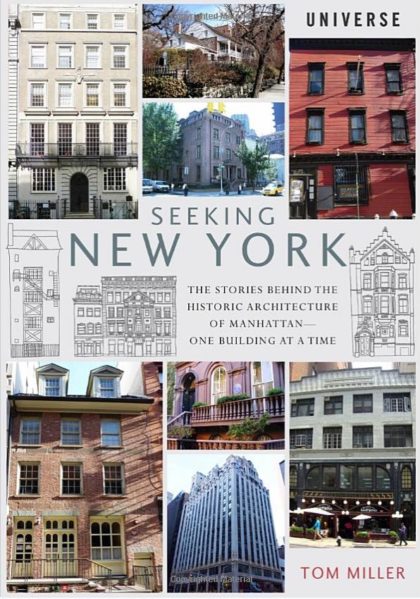 Tom Miller, who writes about the history of Manhattan buildings at Daytonian in Manhattan, has allowed Tribeca Citizen to create a database of his Tribeca posts. If you enjoy these, and you will, then you should definitely check out his website, which also has write-ups about buildings all over the island. And don’t miss his book, Seeking New York: The Stories Behind the Historic Architecture of Manhattan—One Building at a Time.
Tom Miller, who writes about the history of Manhattan buildings at Daytonian in Manhattan, has allowed Tribeca Citizen to create a database of his Tribeca posts. If you enjoy these, and you will, then you should definitely check out his website, which also has write-ups about buildings all over the island. And don’t miss his book, Seeking New York: The Stories Behind the Historic Architecture of Manhattan—One Building at a Time.
··································
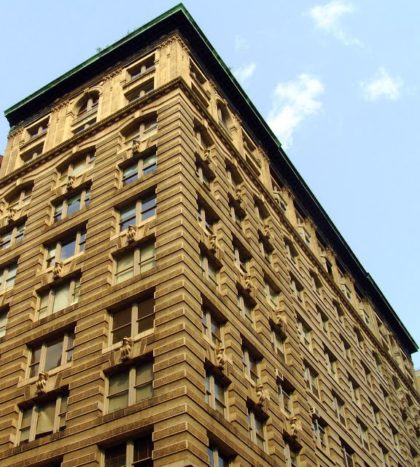 When Virginia Stuart Mackay-Smith sold the property at Nos. 364 and 366 Broadway at the northeast corner of Franklin Street to William C. Stuart in December 1901, the area was already a vibrant commercial district. Stuart paid $350,000 for the corner—more in the neighborhood of $9.25 million in today’s dollars.
When Virginia Stuart Mackay-Smith sold the property at Nos. 364 and 366 Broadway at the northeast corner of Franklin Street to William C. Stuart in December 1901, the area was already a vibrant commercial district. Stuart paid $350,000 for the corner—more in the neighborhood of $9.25 million in today’s dollars.
Real estate operator Louis M. Jones was busy at the time buying up old properties and replacing them with office and loft buildings. Less than two years earlier Louis M. Jones & Co. had demolished Nos. 127 through 135 Bleecker Street and erected what the Real Estate Record & Builders’ Guide called “a seven-story modern business building.” It was Jones who would be responsible for the massive Croisic Building on Madison Square in 1911, prompting the Record & Guide to say, “Slowly but surely old Madison Square, once the center of a residence neighborhood, is being surrounded by the gigantic palisades of commerce.”
But before then he would set his focus on No. 366 Broadway. In 1908, Louis M. Jones & Co. demolished the old structures on the corner lot and set Frederick C. Browne to work on a modern 12-story office building. Completed a year later, it was the last word in Edwardian commercial architecture.
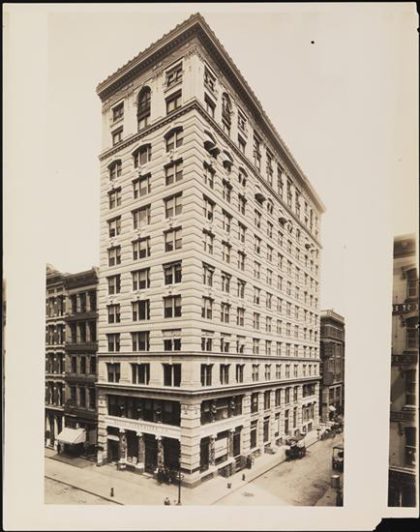 The Museum of the City of New York says this photograph of 366 Broadway was taken circa 1895 (which seems unlikely, given that it was said here to be built in 1909) [x2010.11.732].
The Museum of the City of New York says this photograph of 366 Broadway was taken circa 1895 (which seems unlikely, given that it was said here to be built in 1909) [x2010.11.732].
··································
Designed in three parts, the uppermost section below the overhanging copper cornice was clad in terra cotta. Browne ornamented the eight story brick central section with vermiculated limestone bands and vigorous scrolled keystones with carved heads. It was at the two-story limestone base that the architect let loose.
Hefty fluted and banded piers, some decorated with stylized carved caducei, supported the cornice. The first floor retail space featured five handsome, veined stone columns with Doric capitals. Above each, at the second floor level, were striking near-caryatids—elaborately carved with festoons and laurel-wreathed heads.
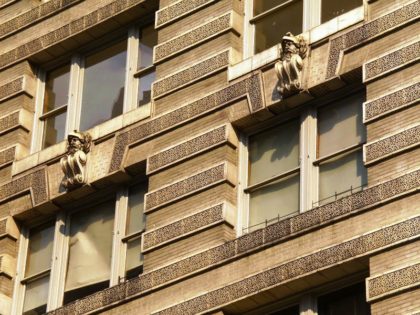 Vermiculated bandcourses and exquisitely-carved keystones distinguish the central portion of the structure.
Vermiculated bandcourses and exquisitely-carved keystones distinguish the central portion of the structure.
··································
The retail store as well as space in the upper floors became home to the Royal Typewriter Company. The firm had sold its first typewriter in March 1906 and just two years later opened its 250,000 square foot factory in Connecticut. On March 12, 1909, The New York Times said, “The store, 50 by 150, will be used as a salesroom, and the space on the upper floors for the executive offices of the company.” The newspaper added, “The building will be known in the future as the Royal Typewriter Building.”
Tenants continued to sign leases, including Warner & Co., a “Stock Exchange house,” which opened a branch office here in July. That fall Royal Typewriter’s rival, the Elliott-Fischer Co. took the entire fifth floor as well as additional space.
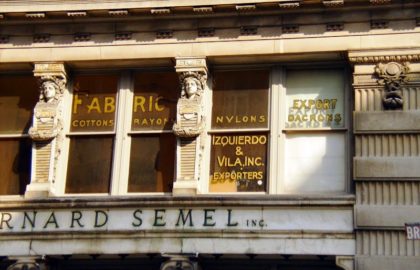 Striking carved columns with female faces adorn the second floor. On the pier to the right, carved snakes entwine to form a stylized caduceus.
Striking carved columns with female faces adorn the second floor. On the pier to the right, carved snakes entwine to form a stylized caduceus.
··································
By 1911 the highly regarded law firm of Goldstein & Goldstein opened its offices in the building. That year the firm took on a new client, a restaurant which wanted to incorporate under the name “Hell.” The attorneys submitted the papers of incorporation to the Secretary of State and it did not take long to get a response. No.
Secretary Lazansky refused to allow a corporation to use the word “Hell,” saying that it would be against public policy. The New York Times explained on September 9, 1911, “It was assumed by the State authorities that some enterprising firm desired to secure the benefits of sensational advertising by displaying an electric sign bearing the name of the company.”
While Royal Typewriters held the majority of the retail space; high-end jeweler Eugene H. Tower & Co. moved its store from next door at No. 368 Broadway around 1910. Before relocating the firm had suffered a loss of about $2000 in a burglary. Unfortunately, the move would not improve the company’s luck.
When the bookkeeper, Miss M. Junker, opened the store here on Wednesday, August 21, 1912, she saw nothing amiss and went straight to work. However a few minutes later, head salesman Charles Giegerich arrived and noticed several missing items. An inventory showed burglars, who had pried open a basement door, had made off with two gross of fountain pen points, “a number of gold and silver pencils, erasers, pocketbooks, safety razors, and knives, in all valued at more than $1,500,” reported The New York Times.
The store’s owner, Eugene Tower, was understandably upset about the theft, which would amount to about $35,000 today. He complained to reporters that the police had never found the first thieves and “we never got a single pen point back.” Now he complained that “the police had asked the firm to keep quiet regarding the burglary,” said The Times.
The textile and apparel industries were centered within the Broadway neighborhood by now. Broker Morris Perlstein, Inc., was in the building in 1914 and only a few months after World War I erupted in Europe, he distributed contracts to knitwear manufacturers amounting to a significant $2,115,000. The companies would supply sweaters, gloves, socks and “stomach bands,” to the English and French armies. Morris Perlstein’s manufacturers were responsible, for instance, for shipping 2,600 dozen sweaters a week.
Along with the need for socks and sweaters, the war brought with it espionage. On November 28, 1914, The Times reported, “Suspicion, steadily increasing since the beginning of the war, that dispatches of the Associated Press were being stolen systematically and were redistributed by smaller news agencies, caused the Associated Press officials to set a trap yesterday for persons they thought had a part in the redistribution of news.”
A detective rented an office at No. 366 Broadway and outfitted it with a safe, office furniture and a New York News Bureau ticker. Working with The Associated Press, the detective carefully watched the dispatches of the New York News Bureau. Within five minutes of the Associated Press sending out its dispatches, they were repeated on the New York News Bureau ticker.
To set its trap, the Associated Press sent out a false news story. It said that on November 27, the Russian warship Fliba had been sunk by a mine with all 450 crew members killed. In fact, there was no such ship and certainly no such disaster. Only The Globe was the intended recipient of the dispatch and that newspaper was told to “kill” the story.
Ten minutes after the dispatch, it appeared on the New York News Bureau ticker and two hours later The Evening Sun ran the headline, “New Russian Battleship is Destroyed by a Mine.” The New York Times reported on November 28, 1914, “When the trap was sprung Henry L. Linder, an operator employed by the Postal Telegraph Company… was arrested and charged with ‘revealing the contents of a telegraphic message to a person other than the one for whom it was intended.'”
In the meantime, Jonah J. Goldstein and his partners continued their legal practice. In April, 1916, the firm was diligently trying to serve papers on the wealthy Albert Gallatin Wheeler, Jr. Wheeler refused to pay his former wife, Claudia Theresa Carlstedt (whom The Times reminded readers was “well known on the musical comedy stage before her marriage”) the $12,500 alimony she had been awarded.
To prevent being served papers, Wheeler refused to leave the Union Club. Goldstein & Goldstein set a “picket guard” outside the club. Jonah Goldstein told reporters, “This Wheeler is harder to ‘get’ than [Pancho] Villa.”
The curious case was still playing out in January. Goldstein & Goldstein notified Wheeler that it would appropriate and sell his seat on the Stock Exchange to procure Mrs. Wheeler her money. When he did not respond, the firm sold the seat. “Mr. Goldstein said the case was without a precedent and was ‘very interesting,’’ said The Times on January 5, 1917.
Goldstein & Goldstein would remain in the building for years while handling high profile cases. In 1921 the firm represented Joseph Cohen, convicted in 1917 as the ringleader of the gang that murdered poultry man Barnet Baff on November 24, 1914, “because his methods were ruining rivals in the poultry business.” Now Jonah J. Goldstein filed for a new trial on the grounds that a witness had committed perjury.
It was not the only murder case that Jonah Goldstein would handle in 1921. He represented Captain Robert Rosenbluth, charged in the murder of Major Alexander P. Cronkhite in Camp Lewis, Washington, in 1919.
The aggressive attorney took the FBI to task for using the grief of the victim’s mother to playing on public sympathies. “The Bureau of Investigation is taking a position that is unfair and far from being American and gentlemanly,” he told reporters. “To make an attempt to hide themselves behind a bereaved and grief-stricken mother is certainly that.”
Another tenant in the building that year, importer M. Weinberg, might have been well served to use Goldberg’s services. The Weinberg family lived in Chappaqua, New York near the home of actor Conway Tearle. In December, 1921, four-year old Jacques Weinberg was passing by the Tearle home when the actor’s butler called him into the yard to give him an orange.
Tearle’s bull terrier, Happy, attacked the boy and bit him on the scalp. It was the beginning of a dramatic chain of events. Little Jacques was taken to the town health officer who directed that the dog be shot so it could be examined. Tearle would not allow it. When the boy was removed to the Babies’ Hospital on E. 55th Street, Dr. Frederick Bartlett also asked that the dog be shot for examination.
When State Troopers finally were sent to the Tearle home, they were informed that the boy was on the actor’s property at the time of the bite. They could not take the dog without an order from the Justice of the Peace.
In the meantime, the boy’s wounds were so bad that his condition was deemed critical. More appeals were sent to Tearle, who continued to refuse to have his dog destroyed. Weinberg promised reporters, “I am going to fight this thing out… That dog should be killed. Even if my child gets well, the dog is dangerous and may injure other children.”
Three months later the boy was still in the hospital and Weinberg brought suit against him for $25,000 damages and expenses. Happy the dog was still alive and doing well.
By now No. 366 Broadway had filled almost entirely (other than Goldstein & Goldstein) with apparel and textile firms. Among those here in 1922 were the New England Cotton Yarn Co.; J. E. Pearl, dealers in “cotton, wool, worsted”; cotton dealers C. M. Plowmad & Co.; Sanford Spinning Co.; underwear manufacturers Edwin Churchman & Co., Hanes Knitting Co., and C. Collier; hosiery firms Cromie & Plunkett and C. G. Culin; and A. G. Campbell makers of knit goods.
When Bernard Semel, Inc., textile jobbers and exporters, moved into the building the firm placed its name in bronze letters between the first and second floors. Although no longer called the Royal Typewriter Building, and technically known as the Broadway Textile Building; Bernard Semel was making its claim.
Three years after Goldstein & Goldstein had taken on accused murderer Robert Rosenbluth’s case and six years after the crime, the trial date neared. Opening arguments were set for September 30, 1924, and Jonah J. Goldstein confidently assured, “The truth will set him free.” Characteristic of the high-profile lawyer, his list of character witnesses was impressive, including Herbert Hoover, Secretary of Commerce, and Governor Pinchot of Pennsylvania.
Throughout the 1930s the building was headquarters for the State Labor Relations Board, where collective bargaining meetings were held. Most of the building’s tenants, however, were still involved in the textile and apparel business.
One of these was Nathaniel Walkof, who had been in the mercantile business for a quarter of a century in 1944. That year, on November 15, the 61-year old was found dead on the floor of his office with a revolver clutched in his hand; the victim of an apparent suicide.
By the second half of the 20th century the Tribeca area was less about manufacturing and apparel companies than it was about trendy restaurants and luxurious lofts-turned-residences. In 1979, the Beaux-Arts style Broadway Textile Building was converted to 38 cooperative apartments, called the Collect Pond House.
No longer the home of typewriters, underwear manufacturers and go-getter lawyers, it is wonderfully intact. And, as they have for over a century, its second floor guardians continue to stare imperiously across the street.
··································
Photo credits from top: Alice Lum; Museum of the City of New York; Alice Lum (2).

















